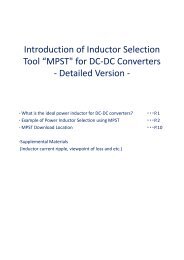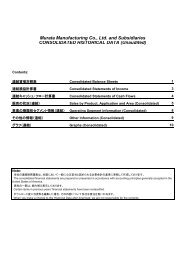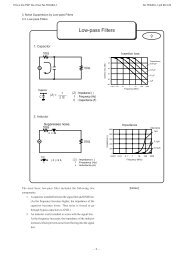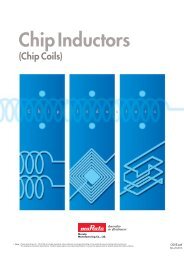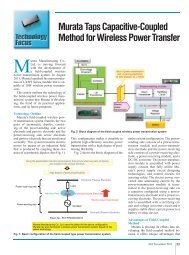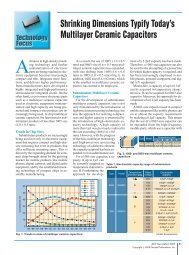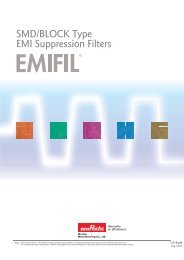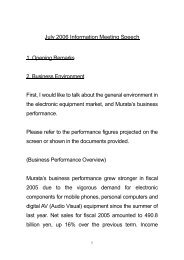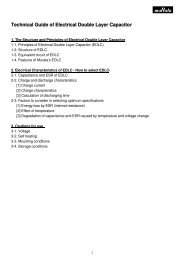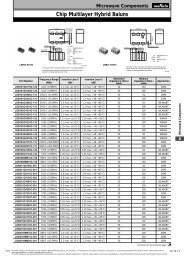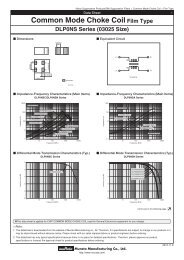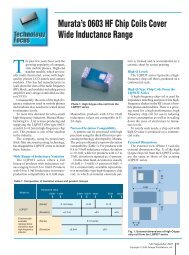Safety Standard Certified Ceramic Capacitors/High Voltage ... - Murata
Safety Standard Certified Ceramic Capacitors/High Voltage ... - Murata
Safety Standard Certified Ceramic Capacitors/High Voltage ... - Murata
Create successful ePaper yourself
Turn your PDF publications into a flip-book with our unique Google optimized e-Paper software.
!Note • Please read rating and !CAUTION (for storage, operating, rating, soldering, mounting and handling) in this catalog to prevent smoking and/or burning, etc.• This catalog has only typical specifications. Therefore, please approve our product specifi cations or transact the approval sheet for product specifi cations before ordering.C85E.pdfApr.7,2014Type KJ Specifications and Test MethodsContinued from the preceding page.No.10 Vibration11 MechanicalShockItemAppearance No marked defect Solder the capacitor and gumCapacitanceD.F.AppearanceCapacitanceD.F.I.R.AppearanceWithin the specified toleranceChar.B, ENo marked defectWithin the specified toleranceChar.B, E10000MΩ min.No marked defectSpecificationsSpecificationsD.F.V2.5%SpecificationsD.F.V5.0%Test Methodup the body to the test jigResin (Adhesive)(glass epoxy board) by resin(adhesive).The capacitor should be firmly soldered to the supporting leadwire, 1.5mm in total amplitude, with about a 20 minutes rate ofvibration change from 10Hz to 2000Hz and back to 10Hz.This motion should be applied 12 times in each of 3 mutuallyperpendicular directions (total of 36 times).The acceleration is 5g max.Solder the capacitor and gumup the body to the testResin (Adhesive)jig (glass epoxy board) byresin (adhesive).Three shocks in each direction should be applied along 3mutually perpendicular axes to and from of the test specimen(18 shocks).The specified test pulse should be half-sine and should have aduration: 0.5ms, peak value: 100g and velocity change: 4.7m/s.12Humidity(UnderSteadyState)CapacitanceChangeD.F.I.R.Char.BEChar.B, E3000MΩ min.Capacitance ChangeWithin ±10%Within ±15%SpecificationsD.F.V5.0%Set the capacitor for 1000±12 hrs. at 85±3°C in 80 to 85%relative humidity.Pre-treatment:Capacitor should be stored at 125±3°C for 1hr., then placedat room condition* for 24±2 hrs. before initial measurements.Post-treatment:Capacitor should be stored for 1 to 2 hrs. at room condition.*DielectricStrengthPer Item 613 HumidityLoadingAppearanceCapacitanceChangeD.F.I.R.No marked defectChar.BEChar.B, E3000MΩ min.Capacitance ChangeWithin ±10%Within ±15%SpecificationsD.F.V5.0%Apply the rated voltage for 1000±12 hrs. at 85±3°C in 80 to85% relative humidity.Pre-treatment:Capacitor should be stored at 125±3°C for 1hr., then placedat room condition* for 24±2 hrs. before initial measurements.Post-treatment:Capacitor should be stored for 1 to 2 hrs. at room condition.*AppearanceCapacitanceChangeI.R.No marked defectWithin ±20%3000MΩ min.Impulse <strong>Voltage</strong>Each individual capacitor should be subjected to a 5kVimpulses for three times. Then the capacitors are applied to lifetest.100 (%)9050Front time (T1) =1.2μs=1.67TTime to half-value (T2) =50μs12300TtT114 LifeDielectricStrengthPer Item 6T2Apply a voltage from Table 4 for 1000 hrs. at 125+2/-0°C, andrelative humidity of 50% max.Applied <strong>Voltage</strong>AC510V(r.m.s.), except that once each hour the voltageis increased to AC1000V(r.m.s.) for 0.1 sec.Pre-treatment:Capacitor should be stored at 125±3°C for 1hr., then placedat room condition* for 24±2 hrs. before initial measurements.Post-treatment:Capacitor should be stored for 1 to 2 hrs. at room condition.** "Room condition" Temperature: 15 to 35°C, Relative humidity: 45 to 75%, Atmospheric pressure: 86 to 106kPaContinued on the following page.72




